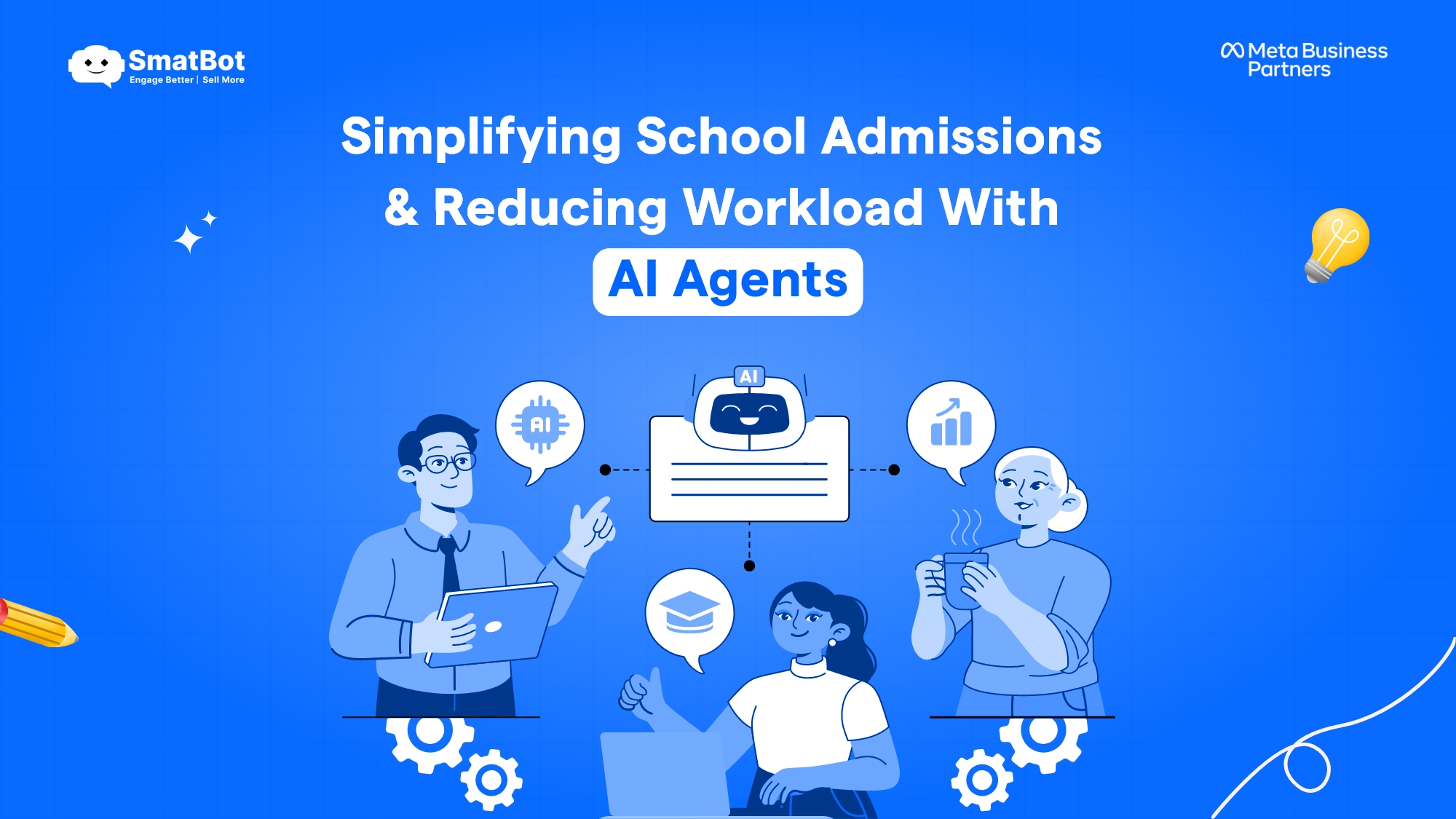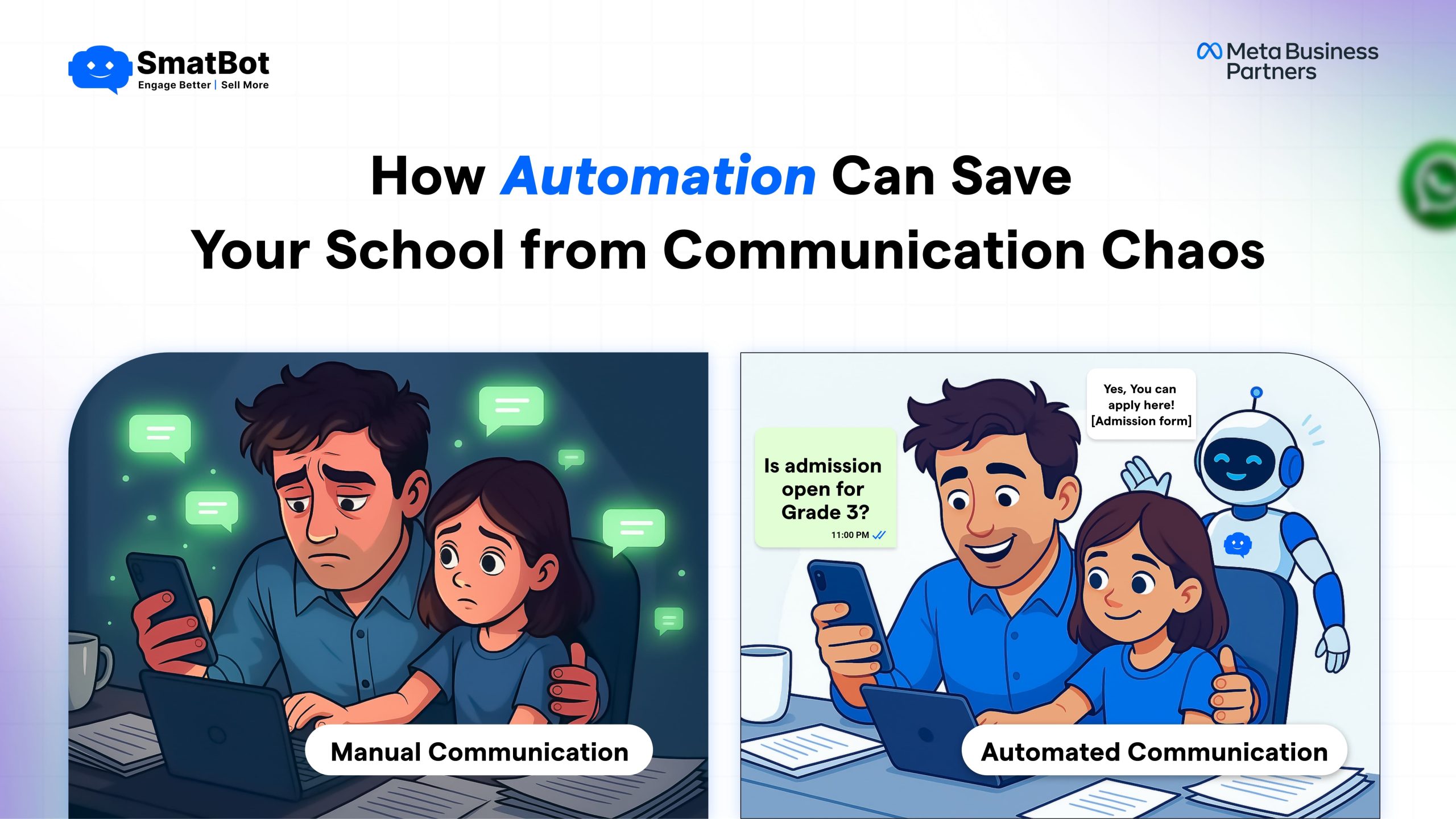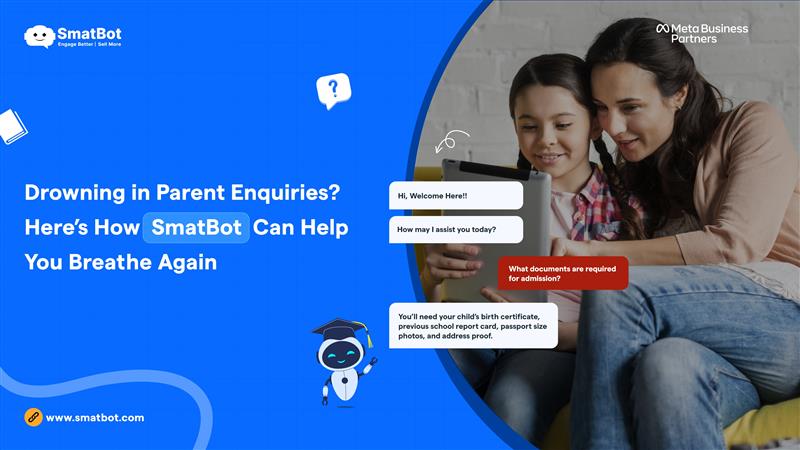Why Is Everyone Talking About Conversational AI Vs Conversational Flows?
Well, now you have decided to deploy a chatbot for your business but are confused about which one to choose conversational AI vs conversational flows.
Generally, when we say chatbot, people feel chatbot can chat just like humans. Yes, they can, but we need humans’ help to meet the needs at some points.
Chatbots come in various forms based on the technology you use and the structure you follow for chatbots to communicate with users.
The chatbots market was estimated at USD 17.17 billion in 2019 and is expected to be USD 102.29 billion by 2025, recording a CAGR of 34.75% over the forecast period, 2020-2025. (Source: mordorintelligence)
If you’re also eager to know which will work best for your business, conversational AI vs conversational flows.
Don’t worry; we are here to take you to the points that can help you decide on a chatbot that will best suit your business.
Let’s start!
Before going through in-depth insights of conversational AI vs conversational flows, let’s first define them for better understanding, followed by their pros and cons.
What is Conversational Flows Chatbot?
Conversational flows are a simple way to start your chatbot. It works on the predefined conversational flows. It means they have already designed conversational flows based on the solution to that asked query.
Consider an example of any clothes shopping brand.
The chatbot provides options>>men or women or kids. If the user selects women, it gives an option for which occasion>>wedding, party, or treat, list of the type of clothes>> dresses, sarees, punjabis, and many more options for selecting size and finally it shows a list of clothes that come under that specification. Let’s have a look at the below image for clarity with another example.
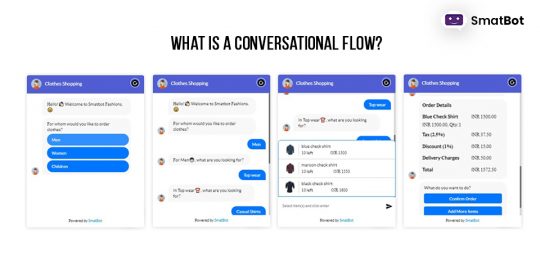
In conversational flows-based chatbot, the user selects the chatbot’s options, and flow goes in that direction until it reaches the user to their end goal.
We can say chatbot is more like an IVR form that we usually encounter while talking to the call center in banks, telecommunication, and other offices.
The flow-based chatbot takes an organized way to a narrow conversational field. It provides options for users to select from it instead of making users type their queries.
Let’s List Out Conversational Flows Pros & Cons
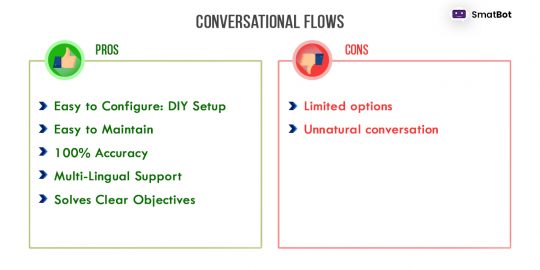
Conversational Flows Pros
-
Easy to Configure: DIY Setup
Chatbot set up is very easy, without the need for any coding. You need to select the predesigned templates, required colors, avatar, bot position, theme, backgrounds (header, chat, question, answer, and options). Adding the name of the bot and welcome text and your bot setup is ready.
-
Easy to Maintain
Suppose the bot gets stuck at some points in conversational flows and doesn’t provide the intended response. You can easily identify that branch and replace it with the new flow or make necessary smooth flow changes.
-
100% Accuracy
Conversational flows-based chatbot builds confidence that your chatbot will provide the right answer because it’s a predefined conversation. If a user asks an ‘A’ question, the chatbot will respond to an ‘A’ answer. It’s going to follow the same conversational flows.
-
Multi-Lingual Support
Conversational flows provide multi-language support to users’ during a chat. It’s a crucial feature for businesses who are into online stores spread across the globe. A multi-lingual bot provides helpful solutions in the user’s comfortable language.
-
Solves Clear Objectives
The conversational flows-based chatbot works towards predefined goals that are specified at the start of the chat. It means the user is evident at the beginning of the chat itself which information they will get by interacting with the bot. It also helps the user get answers easily without getting into any confusion and choosing from the list.
Other Benefits of Conversational Flows Chatbot Include-
- It’s useful for brands that don’t have a history of user query data.
- Develop in minutes.
- Easy to set up using templates.
- Helpful in answering standard FAQs.
Conversational Flows Cons
-
Limited Options
Even though you will get clear answers using conversational flows-based, it may be restrictive when the user needs any other thing apart from predefined options. Users can get answers to questions that are mentioned in the exact script or decision tree.
-
Unnatural conversation
It may make users uncomfortable because they can get answers to only questions that are already defined in the flow, and for others, they won’t get any response. If users type other than predefined questions, the bot can’t understand and takes the conversation further.
Let’s now jump to conversational AI.
What’s a Conversational AI Chatbot?
Conversational AI uses AI and other technologies that enable the systems to understand, process, and respond to text or voice naturally. Alexa and Siri also act as conversational AI chatbots in delivering customer service.
Conversational AI learns from their previous chats, provides solutions even to complex queries faster, and helps businesses deliver better and cheaper personalized support.
Consider an example of a bank; after greetings, when a user asks, “ how much balance is there in my account?” the chatbot replies, can you please wait for a moment. Then it displays the account balance.
Let’s have a look at the image below for another example for Conversational AI.
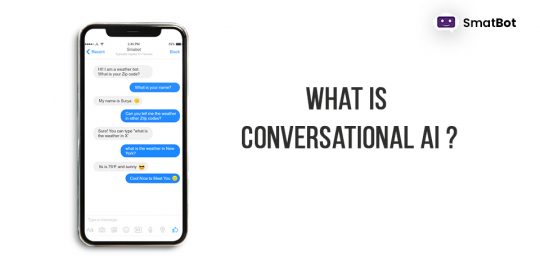
69% of customers opt for chatbots because of the speed it delivers to users when communicating with brands. (Source: Salesforce)
Let’s throw light on the pros and cons of conversational AI chatbot:
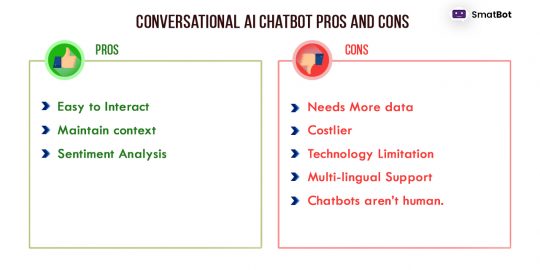
Conversational AI Pros
-
Easy to Interact
A chatbot can take any media (text, audio, image, or video) as an input that is very comfortable for users to interact with brands for their queries. By providing these options, a chatbot can resolve most of the users’ queries in an easy way and in less time.
-
Maintain Context
Most of the NLP engines maintain context and drive the conversation accordingly. It makes users feel human-like when chatting with chatbots.
-
Sentiment Analysis
Unlike a human, conversational AI chatbots are always available to the users. They can detect the sentiments of users and reply accordingly. Also, they always respond in the same manner. A chatbot can speak in multiple languages to interact with a chatbot in their comfortable language and improve overall customer satisfaction.
Conversational AI Cons
-
Needs More data
Conversational AI to deliver the most relevant response for users needs more data as AI chatbot learns from previous responses. Initially, it needs more data; it becomes a more efficient way to interact with your users in the long run.
-
Costlier
Initially, the development cost may be higher, but it will save a lot in the long run. Chatbots are cheaper than employing a human, and also they are available round the clock to users. It became the most probable option to opt for companies that are emerging at a good rate.
Chatbots can assist companies in saving up to 30% on their CX team costs. (Source: IBM)
Conversational AI chatbot is a little costlier than conversational flows chatbots.
-
Technology Limitation
Even though NLU, NLP has reached a good accuracy level. Still, they are in a development stage to achieve human-level accuracy for many domains and use cases.
Using conversational AI, you can’t completely replace humans with chatbots. But it can help the CX team by handling all basic level queries and only complex queries left to them.
-
Multi-lingual Support
Multi-lingual support is not available for most of the NLP engines. It’s still in the developing stage. So, businesses with global audiences who need multi-language support have to look for conversational flows based options or they can go with English.
-
Chatbots Aren’t Human.
Although chatbots have been in drastic improvements day by day, people are still more inclined towards talking with humans than a chatbot.
27% of customers were unsure if the previous interaction is with a chatbot or a real person. (Source: PWC)
The major drawback with a chatbot is, it may not come up with the real solution when things have not gone in the planned way. Context-aware chatbots can resemble human-like conversation to a maximum extent.
So What Do You Think Which Chatbot Can Meet Your Needs? Conversational AI VS Conversational Flows
Most probably, you again got confused, because you need features of both for your business. To your surprise, you can have this too as a hybrid one. SmatBot can help you with this by combining these two features in a single chatbot. Conversational AI to detect intent and then trigger a flow using conversational flows.
How About AI + HUMAN?
AI+Human can meet your needs. Products like ‘SmatAgent’ where auto training for AI would happen.
https://www.youtube.com/watch?time_continue=29&v=gOE_pie1FME&feature=emb_logo
To explain, in ‘SmatAgent’, when the user has a live agent conversation going on, for each query from the user, the agent would get suggested replies on his screen so that agent can choose or edit or write his reply. If a live agent won’t select the reply from given options or make changes in the provided reply, the chatbot learns from it, and next time, when the user asks for such questions, it can suggest more relevant replies to user queries.
SmatAgent helps the live agent answer repetitive questions and FAQs by just selecting it’s suggestions and can spend more time analyzing the solution to user issues than spending time on writing messages.
To Sum Up:
Customers are more inclined towards brands with quick customer service. To provide immediate assistance to customers, brands are turning towards deploying chatbots in their business.
But they are confused about choosing as a chatbot-’conversation AI’ or ‘conversational flows’.
If you are in urgent need of use cases like-
- Lead data collection
- Booking appointments
- Collecting feedback
- Conducting surveys
- Standard Customer Support and more like these.
Then ‘Conversational Flows’ is the best option to opt for.
If you have a history of conversational data between you and your customer, then you can start building AI engines and use the combination when required.
We hope you might have a good idea about which chatbot to select for your business conversational AI Vs conversational flows by going through this article.
If you have any further queries. Feel free to reach us. We are glad to resolve this for you.

